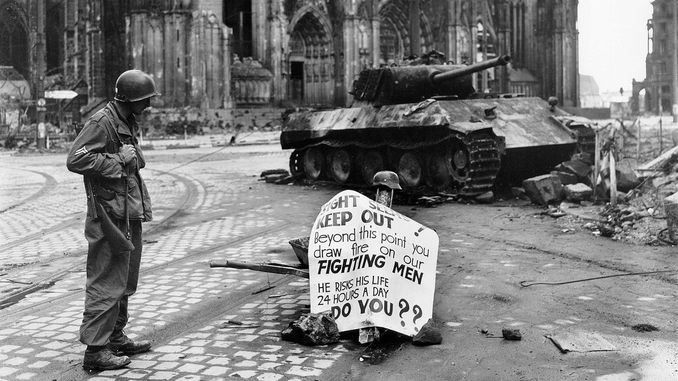
The reforestation at Ofenkaulberg conceals very painful memories. Forced labor in the Ofenkaulen mines and air raids during World War II. The war raged between 1939 and 1945 and affected the civilians more than any war before.
Hitler had wanted this war from the very beginning. Not only to re-establish the German Reich do away with the detested Peace Treaty of Versailles, above all it was a war of conquest and annihilation in the east.
During the first year of World War II, Germany had the upper hand. German troops overran the Netherlands and Belgium and invaded Denmark and Norway. In June 1940, France surrendered. Yet, the “Battle of Britain” got lost, and Hitler had to give up his invasion plans. In summer 1941, Hitler gave orders to invade the Soviet Union, and at the beginning their offensive was very successful. But despite the differences between Western democracies and Soviet communism, first England and then the United States offered the Soviet Union support; the alliance against Nazi-Germany stood.
The Wannsee conference in Berlin 1942 had sanctioned the “Final Solution of the Jewish question”. The Nazis arrested millions of people, mostly Jews but also countless Gypsies, Slavs, and others races, deported and killed them concentration camps in Eastern Europe.
The USA enter World War II
The USA under President Roosevelt has so far remained neutral. But the more Hitler’s rule over Europe threatened, the more they deviated from this line. Whoever could buy American war material and transport it away got it. In March 1941, Congress gave the President the authority to even lend, lease or exchange defense equipment to any country whose defense it considered vital to the protection of the United States. At the same time, more and more American ships came to the aid of British ships on the Atlantic. In September 1941 Roosevelt ordered to sink every German U-boat without warning.
When Japan attacked the US base at Pearl Harbor, the USA and England declared war on Japan. In response, Germany and Italy declared war on the United States.
Terror and blood justice
Within the Third Reich, terror and violence ruled, supported by a more and more brutal blood justice. In Germany, more than 70,000 old and sick people were killed. The Nazis built more concentration camps, most of them in the occupied Eastern territories. Among the countless people who died in concentration camps was Carl von Ossietzky, a journalist and pacifist, he got the Peace Nobel Prize in 1935. Legal opposition or open resistance was impossible, and the individuals and groups who opposed the Nazi Regime risked their lives. Among them were Sophie und Hans Scholl of the White Rose; they were executed in 1943.
Air raids
The tide turned. Since 1942, the allies flew air raids on German cities. On March 31, 1942, the “night of the 1000 bombers”, Cologne was almost completely destroyed. In the east, the German armed forces suffered a devastating defeat in February 1943 in Stalingrad. On June 6, 1944, referred to as D-Day, American, British and Canadian troops landed in Normandy, France. In mid-January 1945, the Red Army broke through the east front and overran East Prussia. Countless treks of refugees fled before the Red Army into interior Germany.
On July 20, 1944, Claus Graf Schenk von Stauffenberg’s assassination plan failed. He and other conspirators were executed the same day.
By the end of April 1945, the situation in Germany had become hopeless. Soviet and Polish forces too Berlin. Hitler killed himself.
Back then in the Siebengebirge
Forced labourers in the Ofenkaulen
When almost all of Cologne lay in ruins and the Allies continued their air raids, the Cologne-based Aero-Stahl Fluggerätebau GmbH moved its production to the Ofenkaulen in the Siebengebirge and brought in forced laborers in autumn 1944. Between 300 and 400 men and women had to work underground and make fuel injection pumps for fighter planes, under the worst conditions.
On March 7, 1945, close to Remagen, American troops had crossed the only Rhine bridge that had remained intact. After embittered fights, particularly around the mountains Löwenburg and Ölberg, they stood in the Siebengebirge. Fierce fighting began, and Königwinter citizens sought shelter there from air raids and artillery fire.
Defeat
From July 7 till August 2, 1945, the last of the allied war conferences took place in Cecilienhof castle in Potsdam. It decided on the future of Germany: the northern part of East Prussia with Königsberg got under Soviet administration; large areas in the east under Polish administration. The remaining German territory as divided in four – an American, a British, Soviet, and a French – zones of occupation whose commanders in chief formed the “Allied Control Council”.
After the war
World War II was over. Many cities had been destroyed by bombs, and many villages lay in ashes. People had very little to eat. Many homes were badly damaged, there was no running water and no electricity. The streets and ways were destroyed, the post and telecommunication system almost paralyzed. The hospitals were overcrowded.
In a booklet in German Heinz Klein from the village of Heisterbacherrott remembers those years. In simple words and with a lot of compassion he writes about families torn apart, of grief and need, and of helpfulness to share the few houses and shelters with the needy and refugees. There is sharing the joy when a family member comes home, and sympathy for the forced labor workers who could finally travel home. There is at first the Allies’ hatred and rejection against all Germans, and then free school meals. He reports about the great need and the hunger in the years after the war. Potatoes, a little bit of fruit and coffee beans were wonderful. Also coal to heat in the bitterly cold winter was a fortune, and people would wait for a freight train to stop to take a bit of coal.
Josef Cardinal Frings, our dear Archbishop of Cologne in those days, had said in his New Year’s Eve sermon 1946 that, in times so hard, it was no sin.
The Siebengebirge was part of the British zone of occupation. In 1947, the federal states of North Rhine-Westphalia, Lower Saxony, Schleswig-Holstein and the city state of Hamburg came into being.
Truman Doctrine and Marshall-Plan
The Soviet sphere of influence became larger and larger, not only in the later “Soviet Bloc”, but also in Greece and in Turkey. Both countries asked the USA for assistance. Also countries in Western Europe were in great need, and the Communist propaganda made use of that. In this situation, US President Truman announced a policy of the “containment”.
On the initiative of the American Minister of Foreign Affairs George C. Marshal began, in 1947, the “European Recovery Program” or simply “Marshal Plan” to “combat hunger, poverty, despair, and chaos. The European states in need received large quantities of food, raw material, machines and also money, so that the economy could recover. In turn, 18 free countries grouped together in the “Organization for European Economic Corporation”, and from this 1960 the “Organization for Economic Cooperation and Development” (OECD) emerged. The Marshall Plan helped a great deal to get Western Germany back on her feet.
Armament and war had led to a collapse of German economy, and the value of the Reichsmark had fallen into a bottomless abyss. The “valid currency” were American cigarettes. Upon the Allies’ orders, many factories, not only in the arms industry, the machines were dismantled and brought abroad. Other factories were not rebuilt. The German economy broke down, and eventually, there was no sufficient income to pay for imported groceries.
“Trizonesia” and currency reform
Finally, the Americans suggested uniting the zones of occupation economically, aiming at a federal state. At the beginning of the year, Americans and British united their zones of occupation into to the Bizone.
The chairman of the economic administration in the Bizone was Ludwig Erhard, he accomplished the currency reform. It was a condition for recovering the economy, and the later “Wirtschaftswunder”, the economic miracle of the 50s.
In 1948, all three western zones united, so the Trizone came into being. In those days, the Rhinelanders sang a carnival song that went “We are the inhabitants of Trizonesia”.
Cold War
“An Iron Curtain has swept across the continent” Winston Churchill
At the same time, the failure of the Allied Control Council became apparent, the differences between the Western powers USA, England, and France on one side and the Soviet Union on the other were too great. The zones occupied by the British, the French, and the USA should become democracies; the Soviet occupation zone should become a communistic country. When the Western powers began negotiations over a uniting their zones of occupation, the Soviet Union left the Allied Control Council in March 1948. In reality, Germany now was a divided country.
Shortly after, the Soviet Union blockaded all roads, railways, and waterways on which goods came into Berlin. But British and American airplanes flew food and coal into the three west sectors. Thanks to the “raisin bombers” and their own great discipline, the people of Berlin got through the winter 1948/49 despite many deprivations. In May 1949, the Soviets lifted the blockade. But the separation and the “Cold War” were there. On October 7, 1949, the constitution of the German Democratic Republic came in force.
20th century
The short 20th century | The Great War | German Revolution 1918/19 | Occupation of the Rhineland | Weimar Republic | Nazi Germany | World War II | Federal Republic of Germany

Be the first to comment